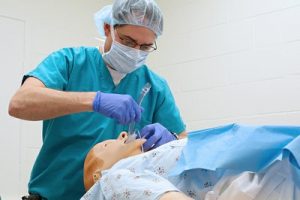UNC is leading the nation with simulation preparation for the Objective Structured Clinical Examination (OSCE) portion of the Applied Examination. Practice OSCEs are held twice a year with video recordings for viewing in addition to constructive feedback from supervising faculty.
Residents engage in the Critical Event Management Simulation (CEMS) series, 2-3 times per year throughout their residency as a part of the core curriculum. The CEMS series focuses on both common and uncommon emergencies encountered in the practice of anesthesiology. Faculty members, many of whom have received specialized simulation training, debrief residents on technical and non-technical crisis resource management (CRM) skills after each scenario. The simulation scenarios are geared towards residents’ level of experience to appropriately educate in a stepwise fashion.
Simulation sessions utilize a state-of-the-art Laerdal SimMan 3G human simulator. The simulator is a full-size manikin which, through its computerized interfaces and realistic bioengineering calculations, lets us conduct a large number of scenarios typical of the operating room environment or the intensive care unit. The simulator is also used by our faculty for simulation education research and for medical student education.
The Department also has the BodyWorks Eve simulator that comes equipped with Transesophageal Echocardiography (TEE), Transthoracic Echocardiography (TTE), and Point-of-Care Ultrasound (POCUS) probes and scenarios. This modality allows our residents to visualize and clearly learn the relationship between the 2D TEE image represented on the screen and the underlying 3D anatomy of the heart, prior to practicing on a live patient. The POCUS probes and scenarios of the BodyWorks simulator complement our POCUS curriculum and training for our residents. The BodyWorks simulator is available to our residents for education and practice 24-7 in the departmental education library.
For procedural training, simulation task trainers are available for all anesthesiology related procedures included central lines, arterial lines, lumbar epidurals, thoracic epidurals, spinals, regional anesthesia, fiberoptic bronchoscopy, surgical airways, and chest tubes.
During the orientation to the clinical anesthesia years, simulation bootcamp sessions are organized to teach new residents the basic fundamentals of anesthesiology including induction, emergence, common hemodynamic and ventilatory issues, OR setup, basics of procedures and their associated kits, and overnight call preparation.
